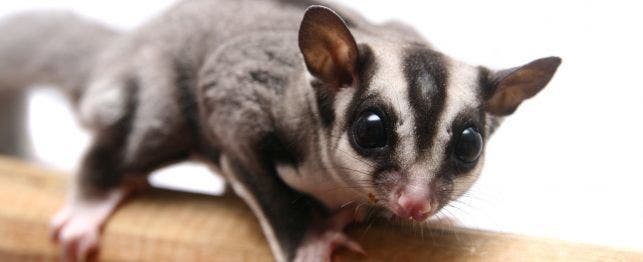
Understanding Your Sugar Glider
Understanding your sugar glider takes time and patience. As you spend time with your pet you will learn to recognize his preferences and personality traits. Once you understand the basics of sugar glider behavior, you’ll be able to figure out how to satisfy his needs. The following is a list of some of the most common behaviors and characteristics of sugar gliders.
Vocalizations
Sugar glider can make a variety of sounds, which are used to express their emotions. Crabbing, barking and sneezing are the most common sounds. Crabbing is a loud sound, similar to an electric pencil sharpener, that usually indicates the glider is frightened or nervous. Short little barks coming from your glider means that your little pet wants some attention and is usually heard when gliders are housed alone. If you house your glider with another glider, which is recommended, you may hear some sneezing type noises. This usually occurs when gliders are competing for food.
In addition, gliders may chatter in the morning and may chirp when content. Some gliders may even purr as another sign of contentment.
Behavior
Although usually calm and sweet pets, some gliders may bite and scratch. They use the sharp claws on their back legs to try to get away. Some poorly socialized or abused gliders may aggressively bite, resulting in a potentially serious wound.
Sugar gliders are nocturnal creatures, which means they tend to be active at night. For this reason, avoid housing your glider in your bedroom. They are very active animals and can glide several feet by using their flaps of skin on their sides.
Social Animals
Sugar gliders are sociable animals and should not be housed alone. It is better to have two gliders to a cage to keep each other company. Gliders crave companionship and love to play. When a glider is frightened, he will usually stand on his hind legs and bare his teeth. Crabbing noises may be heard.
Happy and content gliders may hop from side to side or hop around the cage.
Scents
Like many other animals, sugar gliders have their own unique odor, which may smell a little like sweet musk. The male glider will use the scent gland on top of his head, chest and genital area to rub scent on objects in his cage. The head scent gland looks like a wound or scab but is actually normal. Female gliders have scent glands in their marsupial pouch and genital area.
By learning all you can about the normal behaviors of sugar gliders, you will be better able to provide a safe and comfortable home for your pet. And, this understanding will help you and your glider develop a closer relationship.